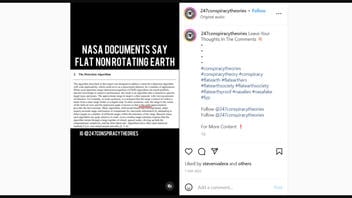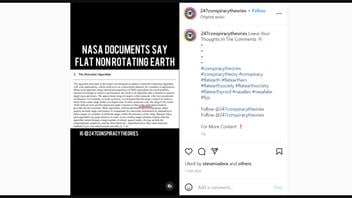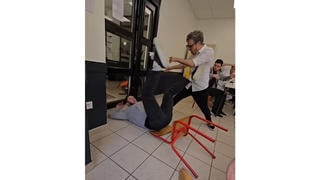

Do NASA documents say that we live on a "flat, nonrotating earth"? No, that's not true: NASA does not believe in a flat-Earth theory of any kind. While the term "flat, nonrotating earth" does appear in NASA documents, it's not referring to the structure of the planet but instead citing mechanisms and assumptions used to analyze flight. In a February 7, 2023, email to Lead Stories, a NASA spokesman said, "This is a mischaracterization of common analysis tools used by the authors of aeronautics studies."
The claim appeared in a post and video on Instagram on February 6, 2023, under the title "NASA DOCUMENTS SAY FLAT NONROTATING EARTH." The description includes:
Leave Your Thoughts In The Comments 👇🏼
•
•
•
•
#conspiracytheories#flatearthsociety #flatearthsociety
This is what the post looked like on Instagram at the time of the writing of this fact check:
(Source: Instagram screenshot taken on Tue Feb 7 18:45:00 2023 UTC)
A NASA reference publication from 1988 called "Derivation and Definition of a Linear Aircraft Model" is one of many documents from the space agency that use the term "flat, nonrotating earth" or a similar expression. In this particular online PDF, it can be found on pages 35 and 108.
In his email to Lead Stories, NASA Public Affairs Officer Rob Margetta said the expression comes from the need for researchers to make a few assumptions to simplify their calculations:
In these cases, researchers assumed a flat, non-rotating Earth. The assumptions made in these studies only reflect the fact that for this kind of analysis, the curvature of the Earth did not affect the calculations in any meaningful way. This by no means implies that NASA believes the Earth to be flat and stationary.
Margetta provided Lead Stories with an example of how the assumption would apply to some of the mischaracterized studies on aircraft trajectory analyses shown in the social media post. He said:
Any airplane, whether a relatively slow general aviation aircraft or a supersonic jet fighter, does not fly anywhere near a speed where the curvature of the Earth has to be accounted for in a trajectory analysis. Only when vehicle speeds approach those required to achieve orbit is the curvature of the Earth significant. For all intents and purposes, airplanes in flight can be treated as flying over a flat domain. This is why the authors of the reports cited can state that their analyses assume a flat, non-rotating Earth. It's a matter of scale, and the Earth is too large for airplanes to have to account for its curvature in flight.
Earth is a sphere
How do we know that our planet is basically a big spinning ball? The University of Nevada, Las Vegas (UNLV), offers this example in an article titled "Round Earth Clues: How Science Proves that our Home is a Globe." It says:
Hop on a plane, and fly to Cape Town, South Africa, or Melbourne, Australia -- two major cities located in the Southern Hemisphere. There, you won't be able to see the North Star.
By the same token, the night sky appears different depending on what part of the world you're in. That wouldn't be the case if the world were flat. It would essentially be the same for every location. Another example of the curvature of the Earth would be when a ship disappears beyond the horizon as it sails away.
These examples and a few others can be found in this video by MinutePhysics called "TOP 10 REASONS Why We Know the Earth is Round":
Earth is really big
It's easy to see where people, especially in ancient times, might believe the Earth is flat because that's what it looks like from our vantage point on the ground. At 24,901 miles around at the equator, it's tough to see enough of the planet to tell that it's curved. The UNLV article explains why:
The misconception that the Earth must be flat because it looks flat to us arises simply because the Earth is big. The height of an adult is much less than one millionth of the Earth's radius. In order to see the curvature of the Earth in a single field of view, you would need to be perched above the surface a sizable fraction of that radius, and one millionth wouldn't be considered 'sizable.'
Nothing new
The Earth being a globe is not a new concept. It's been around for a couple of millennia. The NASA website offers these details from the article "What Is Earth?":
Humans have known that Earth is round for more than 2,000 years! The ancient Greeks measured shadows during summer solstice and also calculated Earth's circumference. They used positions of stars and constellations to estimate distances on Earth. They could even see the planet's round shadow on the moon during a lunar eclipse. (We still can see this during lunar eclipses.)
Today, scientists use geodesy, which is the science of measuring Earth's shape, gravity and rotation. Geodesy provides accurate measurements that show Earth is round. With GPS and other satellites, scientists can measure Earth's size and shape to within a centimeter. Pictures from space also show Earth is round like the moon.
Other Lead Stories fact checks of flat Earth claims can be found here.

















